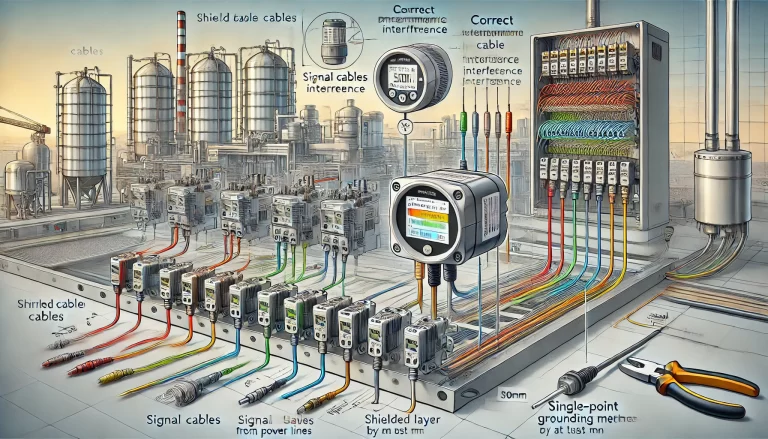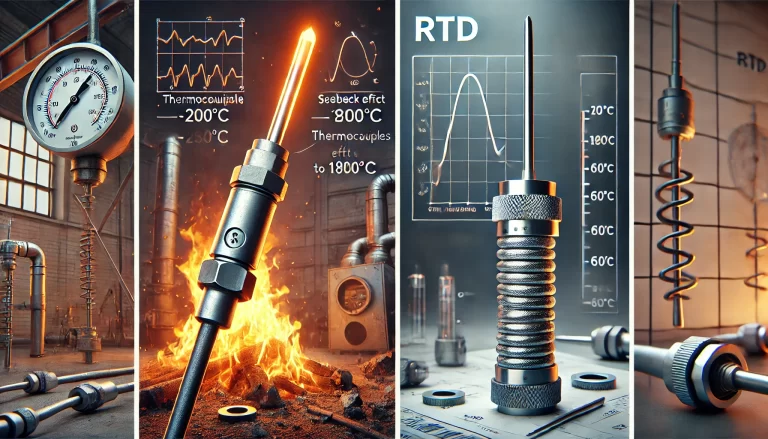1. Signal Amplification in Temperature Transmitters
Temperature transmitters play a vital role in industrial automation by converting physical temperature signals into standardized electrical signals for monitoring and control. Unlike sensors that typically generate raw signals, transmitters integrate multiple functions such as signal amplification, cold-junction compensation, linearization, and current output conversion.
1.1 Thermocouple Temperature Transmitter
A thermocouple temperature transmitter typically consists of the following modules:
Reference voltage source
Cold junction compensation
Amplifier circuit
Linearization circuit
Voltage-to-current (V/I) conversion
Broken sensor detection
Reverse polarity protection
Current limiting protection
The thermocouple generates a millivolt-level thermoelectric voltage, which is first compensated for ambient temperature (cold junction). The compensated signal is amplified, then passed through a linearization circuit to correct the non-linear relationship between voltage and temperature. Finally, the signal is converted to a standardized 4–20 mA output current.

1.2 RTD Temperature Transmitter
An RTD (Resistance Temperature Detector) temperature transmitter typically includes:
Precision reference unit
Resistance-to-voltage (R/V) conversion circuit
Linearization circuit
Reverse polarity protection
Current limiting protection
V/I conversion unit
The RTD’s resistance variation is first converted to a voltage, then amplified. A linearization module compensates for the non-linear resistance-temperature relationship. The processed signal is then converted into a 4–20 mA current output proportional to the measured temperature.

1.3 Integrated (Head-Mounted) Temperature Transmitter
Integrated temperature transmitters combine the sensing probe (thermocouple or RTD) with a two-wire transmitter module housed within the connection head. This compact form factor simplifies installation and wiring, especially in environments with limited space.
Integrated models are typically divided into:
Thermocouple-type transmitters
RTD-type transmitters
2. Role of Temperature Transmitters in Measurement Systems
Temperature transmitters are essential in transforming low-level sensor signals into standard industrial signals (e.g., 4–20 mA), which can be directly interfaced with display units, data loggers, PLCs, DCS, or control systems.
2.1 Key Functions
Signal Standardization: Converts thermocouple millivolt signals or RTD resistance changes into unified analog signals.
Remote Transmission: Enables long-distance signal integrity over 4–20 mA loops.
System Integration: Allows direct input into automation systems for monitoring, control, or feedback loops.
Data Digitization: Interfaces with computers or industrial control systems for SCADA/HMI applications.

3. Common Issue: No Output Signal – Troubleshooting Guide
One of the most frequently encountered issues in temperature transmitters is the absence of output. Below are key steps for diagnosis:
| Checklist Item | Action |
|---|---|
| 🔌 Power Supply Polarity | Confirm correct polarity; reverse wiring may disable output. |
| 🔋 Power Voltage | Ensure supply voltage ≥ 12V at transmitter input terminal (typical: 24VDC). |
| 🔍 Loop Integrity | Check for wire disconnections or high impedance load (≤ 250Ω recommended). |
| 💡 LCD Display Damage | If equipped with display, short display terminals. If output resumes, replace display. |
| 🔁 Current Measurement | Insert a milliammeter in series to verify if transmitter outputs current. |
| ⚡ Correct Terminal Connection | Ensure wiring is properly connected to the transmitter’s power input terminals. |
4. Maintenance Recommendations
Conduct regular inspections of wiring terminals and sensor connections.
Store spare parts such as LCD displays or transmitter modules for quick replacement.
When sensitive internal components fail, replacement by end-users is usually not feasible—contact the manufacturer or authorized service partner for support.

Conclusion
Understanding the amplification and standardization functions of temperature transmitters helps ensure accurate temperature monitoring and reliable automation. Regular maintenance and quick fault isolation further enhance the overall stability of industrial temperature measurement systems.
